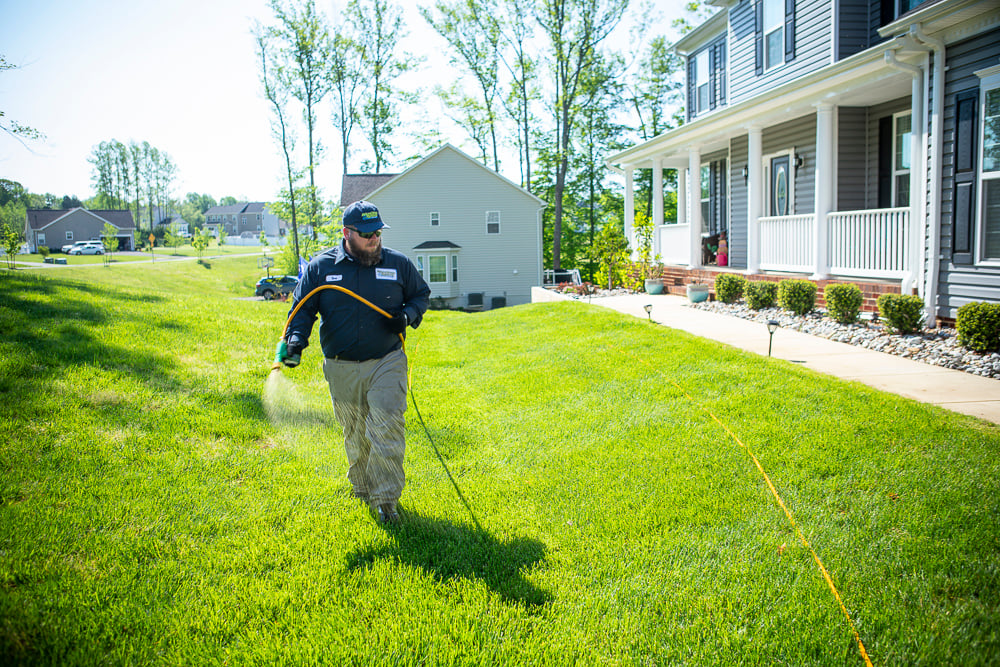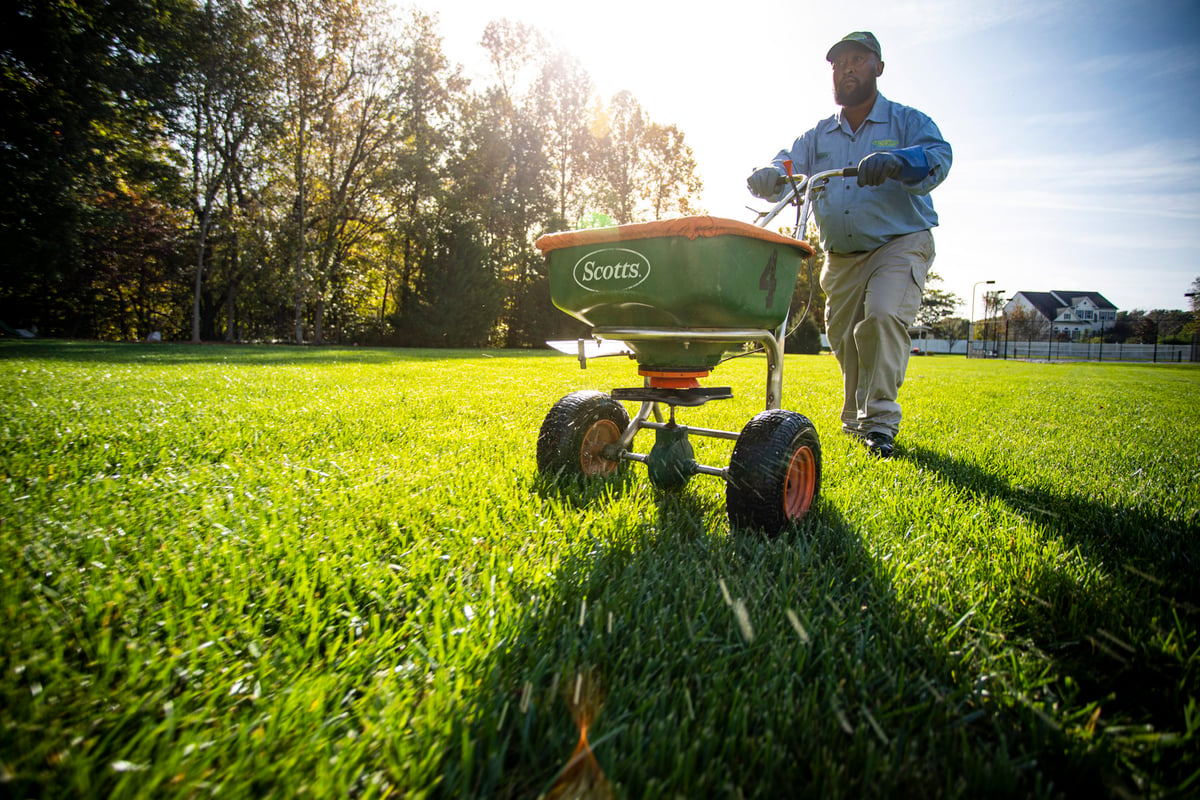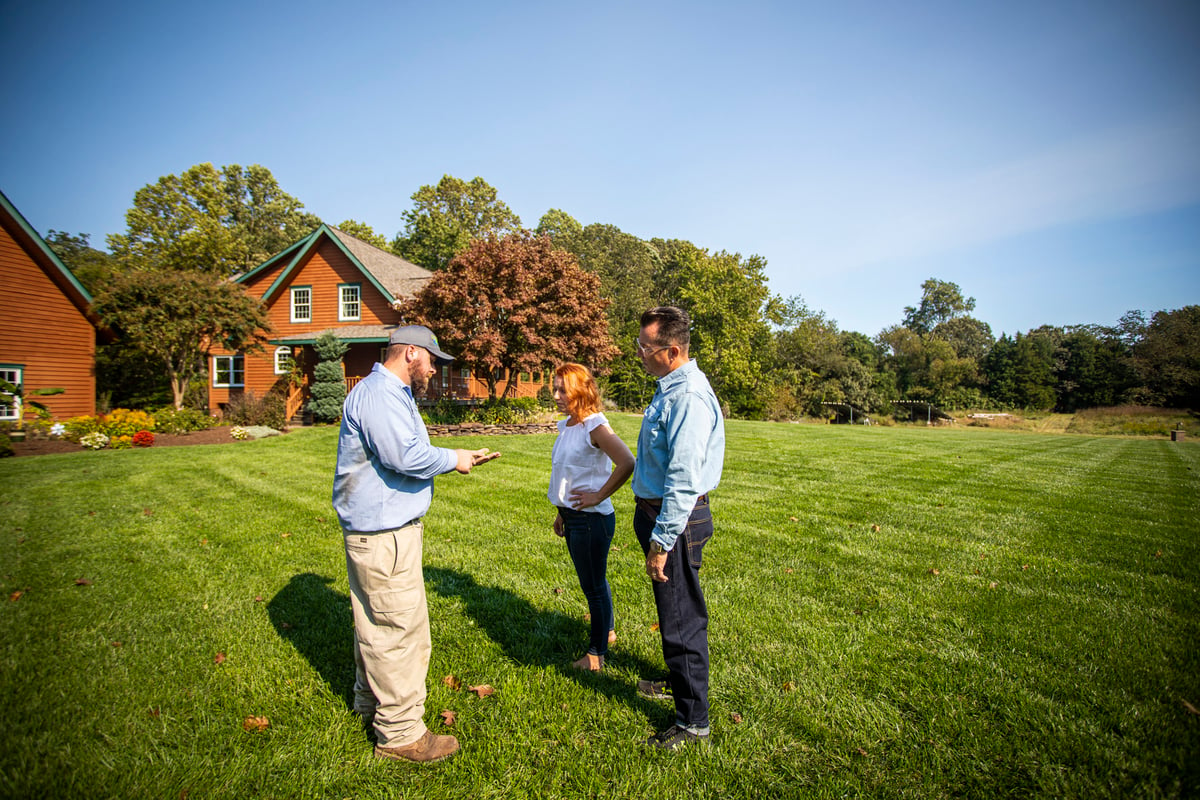Why Does Your Grass Have White Spots? Is it Powdery Mildew?
It can happen suddenly one day in spring.
You’re walking outside to enjoy the warm weather, and instead of the green, rich, thick grass you’re used to sinking your toes into, you find a few silvery, white patches. It almost looks like someone took talc or baby powder and sprinkled it on your lawn.
What is this? White is not the normal color of your lawn? You take such great care of your Maryland lawn that you shouldn’t have to deal with this. Where’s your beloved green grass?
The bad news: You might have a fungus called powdery mildew. The good news: There are ways to take care of it, so you can stop seeing a white power coating on your grass blades and get back to that emerald color you love.
Let’s look at what causes powdery mildew on grass and how to treat it so you can get back to regularly scheduled outdoor enjoyment.
Powdery Mildew on Grass in Maryland
The white spots on your grass blades are caused by a fungus called powdery mildew. It’s a bizarre addition to your normally green lawn, for sure.
Knowing how to identify this fungus and treat it properly so it stops giving your lawn that funny appearance is challenge No. 1.
What is Powdery Mildew on Grass?
When powdery mildew strikes, you’ll first see isolated patches of whitish, powdery growth on the surfaces of your grass blades.
 Over time, if the conditions don’t go away, powdery mildew on grass will become more dense and may cover the entire blade. You might see entire sections of your grass turf a dull white.
Over time, if the conditions don’t go away, powdery mildew on grass will become more dense and may cover the entire blade. You might see entire sections of your grass turf a dull white.
What Causes Powdery Mildew on Grass?
In Maryland, any lawn can be susceptible to powdery mildew.
The disease develops best on cool-season grasses like tall fescue and Kentucky bluegrass.
Use This Tool to Compare Your Local Lawn Care Companies
The white spots on grass tend to show up in shaded areas and when higher amounts of moisture are present. This is usually when the seasons are shifting – from winter to spring, for instance.
Moderate air temperature and high humidity, particularly in the face of poor air circulation, create favorable conditions for this disease to spring up.
Powdery Mildew Grass Treatment Options
Some of the conditions that can cause powdery mildew on grass, such as humidity and wet weather, are unfortunately out of your control. Mother Nature has a mind of her own.
But once you have powdery mildew, the mold will send spores to nearby plants in the wind. Fast-acting, this can infect other plants and grass areas pretty quickly.
 While the major impact may not be fatal to your plants, it can look unsightly, as well as stress your grass out. Over time and with repeated infection, your grass can start to die out. The white spots on grass can coat the blades so much that it blocks sunlight from reaching them.
While the major impact may not be fatal to your plants, it can look unsightly, as well as stress your grass out. Over time and with repeated infection, your grass can start to die out. The white spots on grass can coat the blades so much that it blocks sunlight from reaching them.
Preventing and treating this fungus is possible with some proper preventive lawn care.
Lawn TLC Can Help Defend It Against Powdery Mildew
To avoid white spots on grass, keep preventive lawn care maintenance at the top of your outdoor to-do list.
 This might sound like a lot of work, but there are really some simple ways to keep your lawn happy and healthy. Don’t neglect these basic steps:
This might sound like a lot of work, but there are really some simple ways to keep your lawn happy and healthy. Don’t neglect these basic steps:
- Never over- or under-water. Since varying degrees of moisture – from not enough to excess – can bring on powdery mildew, you want to ensure your lawn dries out before evening so there aren’t extended periods of wet grass happening as humidity rises. Early morning watering can aid drying out your grass between waterings.
- Amplify airflow. You want to improve airflow in your lawn to ensure it dries out and doesn’t sit with moisture and humidity hanging over it. Fall aeration can help do this. Overseeding at the same time can ensure your grass thickens up, eliminating bare spots.
- Proper fertilization. Correct fertilization starts with a soil test so you know what your lawn is lacking. Then your lawn care professional can tailor a fertilization program to your lawn.
- Mow correctly. A fungus like powdery mildew takes advantage of stressed lawns. If you cut your lawn too short or cut off too much at once, you risk amplifying stress. Keep your lawn to a 3- to 4-inch height with weekly mowings during the growing season.
Fungicide Treatments for Powdery Mildew
For severe powdery mildew on grass or some that persists for longer periods of time, fungicide treatments are an option.
 If powdery mildew doesn’t go away on its own or continues spreading, calling in a lawn care professional for a more extensive look and treatment plan may be the best approach.
If powdery mildew doesn’t go away on its own or continues spreading, calling in a lawn care professional for a more extensive look and treatment plan may be the best approach.
Eliminate White Spots on Grass For Good
Taking care of your lawn is always the best way to keep a fungus like powdery mildew from taking over your lawn. And if you do see white spots on grass blades, continuing proper care can help take them away.
But if conditions are prime for powdery mildew growth, you might find yourself feeling lost. Don’t worry; instead, give Natural Green a call. We see these types of fungi and diseases in Maryland lawns all the time and can help you properly and quickly identify the problem and treat it, so it quickly disappears.
Is powdery mildew making you see white sections in your lawn? We’d love to help. Get started today with a free quote. Together, we’ll prepare a customized plan for your Central or Southern Maryland lawn so you can make an educated decision.
Image Source: powdery mildew
It can happen suddenly one day in spring.
You’re walking outside to enjoy the warm weather, and instead of the green, rich, thick grass you’re used to sinking your toes into, you find a few silvery, white patches. It almost looks like someone took talc or baby powder and sprinkled it on your lawn.
What is this? White is not the normal color of your lawn? You take such great care of your Maryland lawn that you shouldn’t have to deal with this. Where’s your beloved green grass?
The bad news: You might have a fungus called powdery mildew. The good news: There are ways to take care of it, so you can stop seeing a white power coating on your grass blades and get back to that emerald color you love.
Let’s look at what causes powdery mildew on grass and how to treat it so you can get back to regularly scheduled outdoor enjoyment.
Powdery Mildew on Grass in Maryland
The white spots on your grass blades are caused by a fungus called powdery mildew. It’s a bizarre addition to your normally green lawn, for sure.
Knowing how to identify this fungus and treat it properly so it stops giving your lawn that funny appearance is challenge No. 1.
What is Powdery Mildew on Grass?
When powdery mildew strikes, you’ll first see isolated patches of whitish, powdery growth on the surfaces of your grass blades.
 Over time, if the conditions don’t go away, powdery mildew on grass will become more dense and may cover the entire blade. You might see entire sections of your grass turf a dull white.
Over time, if the conditions don’t go away, powdery mildew on grass will become more dense and may cover the entire blade. You might see entire sections of your grass turf a dull white.
What Causes Powdery Mildew on Grass?
In Maryland, any lawn can be susceptible to powdery mildew.
The disease develops best on cool-season grasses like tall fescue and Kentucky bluegrass.
Use This Tool to Compare Your Local Lawn Care Companies
The white spots on grass tend to show up in shaded areas and when higher amounts of moisture are present. This is usually when the seasons are shifting – from winter to spring, for instance.
Moderate air temperature and high humidity, particularly in the face of poor air circulation, create favorable conditions for this disease to spring up.
Powdery Mildew Grass Treatment Options
Some of the conditions that can cause powdery mildew on grass, such as humidity and wet weather, are unfortunately out of your control. Mother Nature has a mind of her own.
But once you have powdery mildew, the mold will send spores to nearby plants in the wind. Fast-acting, this can infect other plants and grass areas pretty quickly.
 While the major impact may not be fatal to your plants, it can look unsightly, as well as stress your grass out. Over time and with repeated infection, your grass can start to die out. The white spots on grass can coat the blades so much that it blocks sunlight from reaching them.
While the major impact may not be fatal to your plants, it can look unsightly, as well as stress your grass out. Over time and with repeated infection, your grass can start to die out. The white spots on grass can coat the blades so much that it blocks sunlight from reaching them.
Preventing and treating this fungus is possible with some proper preventive lawn care.
Lawn TLC Can Help Defend It Against Powdery Mildew
To avoid white spots on grass, keep preventive lawn care maintenance at the top of your outdoor to-do list.
 This might sound like a lot of work, but there are really some simple ways to keep your lawn happy and healthy. Don’t neglect these basic steps:
This might sound like a lot of work, but there are really some simple ways to keep your lawn happy and healthy. Don’t neglect these basic steps:
- Never over- or under-water. Since varying degrees of moisture – from not enough to excess – can bring on powdery mildew, you want to ensure your lawn dries out before evening so there aren’t extended periods of wet grass happening as humidity rises. Early morning watering can aid drying out your grass between waterings.
- Amplify airflow. You want to improve airflow in your lawn to ensure it dries out and doesn’t sit with moisture and humidity hanging over it. Fall aeration can help do this. Overseeding at the same time can ensure your grass thickens up, eliminating bare spots.
- Proper fertilization. Correct fertilization starts with a soil test so you know what your lawn is lacking. Then your lawn care professional can tailor a fertilization program to your lawn.
- Mow correctly. A fungus like powdery mildew takes advantage of stressed lawns. If you cut your lawn too short or cut off too much at once, you risk amplifying stress. Keep your lawn to a 3- to 4-inch height with weekly mowings during the growing season.
Fungicide Treatments for Powdery Mildew
For severe powdery mildew on grass or some that persists for longer periods of time, fungicide treatments are an option.
 If powdery mildew doesn’t go away on its own or continues spreading, calling in a lawn care professional for a more extensive look and treatment plan may be the best approach.
If powdery mildew doesn’t go away on its own or continues spreading, calling in a lawn care professional for a more extensive look and treatment plan may be the best approach.
Eliminate White Spots on Grass For Good
Taking care of your lawn is always the best way to keep a fungus like powdery mildew from taking over your lawn. And if you do see white spots on grass blades, continuing proper care can help take them away.
But if conditions are prime for powdery mildew growth, you might find yourself feeling lost. Don’t worry; instead, give Natural Green a call. We see these types of fungi and diseases in Maryland lawns all the time and can help you properly and quickly identify the problem and treat it, so it quickly disappears.
Is powdery mildew making you see white sections in your lawn? We’d love to help. Get started today with a free quote. Together, we’ll prepare a customized plan for your Central or Southern Maryland lawn so you can make an educated decision.
Image Source: powdery mildew
Share This
Topics: Lawn Care


